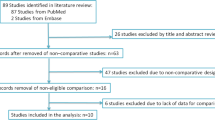Abstract
Objective
Auxiliary nephrolithometric scoring systems (NSSs) have been developed to predict complications and treatment success of conventional percutaneous nephrolithotomy (PCNL). However, to our knowledge, there is no study comparing these NSSs in patients undergoing miniPCNL. This study aimed to compare the NSSs in terms of their ability to predict miniPCNL-related complications and treatment success.
Methods
The data of patients undergoing PCNL between September 2016 and May 2018 were retrospectively reviewed through the electronic medical record system, and 140 patients were included in our study. Stone-free status was evaluated using non-contrast computed tomography between 1 and 3 months after the procedure. PCNL was considered successful if the patient was completely stone free. The postsurgical complications were classified according to the modified Clavien–Dindo classification system.
Results
The Clinical Research Office of the Endourological Society (CROES) and STONE NSSs significantly predicted miniPCNL treatment success (p = 0.043, p = 0.018). However, the Guy’s NSS did not significantly predict the treatment success (p = 0.415). Guy’s, CROES and STONE NSSs were not found to significantly predict postsurgical complications (p = 0.584, p = 0.823, p = 0.189).
Conclusion
To the best of our knowledge, our study is the first of its kind to investigate the ability of NSSs to predict treatment success and postsurgical complications in patients undergoing miniPCNL. The study found that STONE and CROES NSSs are independent parameters for predicting stone-free status after miniPCNL. In addition, our study found that none of the NSSs were useful in predicting postsurgical complications in patients undergoing miniPCNL.


Similar content being viewed by others
References
Türk C, Petřík A, Sarica K, Seitz C, Skolarikos A, Straub M, Knoll T (2016) EAU guidelines on diagnosis and conservative management of urolithiasis. Eur Urol 69:468–474. https://doi.org/10.1016/j.eururo.2015.07.040
Jackman SV, Docimo SG, Cadeddu JA, Bishoff JT, Kavoussi LR, Jarrett TW (1998) The “mini-perc” technique: a less invasive alternative to percutaneous nephrolithotomy. World J Urol 16:371–374. https://doi.org/10.1007/s003450050083
Thomas K, Smith NC, Hegarty N, Glass JM (2011) The Guy’s stone score–grading the complexity of percutaneous nephrolithotomy procedures. Urology 78:277–281. https://doi.org/10.1016/j.urology.2010.12.026
Smith A, Averch TD, Shahrour K, Opondo D, Daels FP, Labate G, Turna B, de la Rosette JJ, CROES PCNL Study Group (2013) A nephrolithometric nomogram to predict treatment success of percutaneous nephrolithotomy. J Urol 190:149–156. https://doi.org/10.1016/j.juro.2013.01.047
Okhunov Z, Friedlander JI, George AK, Duty BD, Moreira DM, Srinivasan AK, Hillelsohn J, Smith AD, Okeke Z (2013) STONE nephrolithometry: novel surgical classification system for kidney calculi. Urology 81:1154–1159. https://doi.org/10.1016/j.urology.2012.10.083
Tefekli A, Ali Karadag M, Tepeler K, Sari E, Berberoglu Y, Baykal M, Sarilar O, Muslumanoglu AY (2008) Classification of percutaneous nephrolithotomy complications using the modified clavien grading system: looking for a standard. Eur Urol 53:184–190. https://doi.org/10.1016/j.eururo.2007.06.049
Ozgor F, Yanaral F, Savun M, Ozdemir H, Sarilar O, Binbay M (2018) Comparison of STONE, CROES and Guy’s nephrolithometry scoring systems for predicting stone-free status and complication rates after percutaneous nephrolithotomy in obese patients. Urolithiasis 46:471–477. https://doi.org/10.1007/s00240-017-1003-0
Schulz KF, Altman DG, Moher D, CONSORT Group (2010) CONSORT 2010 statement: updated guidelines for reporting parallel group randomised trials. BMJ 340:c332. https://doi.org/10.1136/bmj.c332
Polat S, Yarimoglu S, Koras O, Sahan M, Sefik E, Bozkurt IH, Degirmenci T (2021) Comparison of Guy’s, S.T.O.N.E. and CROES scoring systems for predicting percutaneous nephrolithotomy outcomes in eldery patients. J Coll Physicians Surg Pak 31(3):307–313. https://doi.org/10.29271/jcpsp.2021.03.307
Bozkurt IH, Aydogdu O, Yonguc T, Yarimoglu S, Sen V, Gunlusoy B, Degirmenci T (2015) Comparison of Guy and Clinical Research Office of the Endourological Society nephrolithometry scoring systems for predicting stone-free status and complication rates after percutaneous nephrolithotomy: a single center study with 437 cases. J Endourol 29:1006–1010. https://doi.org/10.1089/end.2015.0199
Yarimoglu S, Bozkurt IH, Aydogdu O, Yonguc T, Gunlusoy B, Degirmenci T (2017) External validation and comparisons of the scoring systems for predicting percutaneous nephrolithotomy outcomes: a single center experience with 506 cases. J Laparoendosc Adv Surg Tech A 27:1284–1289. https://doi.org/10.1089/lap.2017.0355
Yarimoglu S, Bozkurt IH, Aydogdu O, Yonguc T, Sefik E, Topcu YK, Degirmenci T (2017) External validation and comparison of the scoring systems (S.T.O.N.E, Guy, CROES, S-ReSC) for predicting percutaneous nephrolithotomy outcomes for staghorn stones: a single center experience with 160 cases. Kaohsiung J Med Sci 33:516–522. https://doi.org/10.1016/j.kjms.2017.06.017
Labadie K, Okhunov Z, Akhavein A, Moreira DM, Moreno-Palacios J, Del Junco M, Okeke Z, Bird V, Smith AD, Landman J (2015) Evaluation and comparison of urolithiasis scoring systems used in percutaneous kidney stone surgery. J Urol 193:154–159. https://doi.org/10.1016/j.juro.2014.07.104
Elkoushy MA, Metwally AH, Noureldin YA (2016) Implications of different nephrolithometry scoring systems on clinical practice of endourologists: an international web-based survey. Arab J Urol 14:216–222. https://doi.org/10.1016/j.aju.2016.04.005
Funding
The authors did not receive support from any organization for the submitted work.
Author information
Authors and Affiliations
Contributions
All authors contributed to the study conception and design. All authors read and approved the final manuscript.
Corresponding author
Ethics declarations
Conflict of interest
The authors have no relevant financial or non-financial interests to disclose.
Ethics approval
All procedures performed in studies involving human participants were in accordance with the ethical standards of the institutional and/or national research committee and with the 1964 Helsinki Declaration and its later amendments or comparable ethical standards. The study was approved by the ethics committee of the Istanbul Training and Research Hospital (No: 1573).
Additional information
Publisher's Note
Springer Nature remains neutral with regard to jurisdictional claims in published maps and institutional affiliations.
Rights and permissions
About this article
Cite this article
Ayranci, A., Ucpinar, B., Caglar, U. et al. Does nephrolithometry scoring systems predict success and complications in miniPCNL?. Int Urol Nephrol 54, 1207–1213 (2022). https://doi.org/10.1007/s11255-022-03174-9
Received:
Accepted:
Published:
Issue Date:
DOI: https://doi.org/10.1007/s11255-022-03174-9




